![]()
ORIGINS OF THE FLORA
The Ketona Glades and their environs provide suitable habitat for more than 60 vascular or nonvascular plant taxa of conservation concern. This is an extraordinary number for a habitat that totals roughly only 100 hectares, marking these areas as one of the most significant reservoirs of botanical diversity in the eastern United States. While all of the factors responsible for the development of the unique Ketona Glade ecosystem may never be fully understood, especially the full phylogenetic histories of the strict endemics, enough is known to suggest some hypotheses.
It seems certain that edaphic factors, especially soil chemistry, have played a major role in the development of the characteristic Ketona Glade communities. In addition to the four samples of topsoil indicated previously as having been submitted to the state Soil Testing Laboratory of Georgia, we gathered samples from several other rock outcrop communities and submitted them also, for comparison. The results are summarized in Table 3. When compared to other outcrop soils, that of Ketona Glades is seen to be extremely high in the element magnesium. The Ketona Formation is, as stated earlier, an exceptionally pure dolomite, comparatively free of the usual siliceous impurities that serve to dilute the levels of magnesium and calcium in a mineral otherwise composed almost entirely of CaCO3 and MgCO3, in a ratio of about 55:45 (Rheams 1992).
|
Table 3. Summary of routine soil analyses performed by Soil Testing Laboratory, Georgia Cooperative Extension Service* |
||||||||||
|
State |
County |
Site Name |
Parent Material |
pH |
P |
K |
Ca |
Mg |
Zn |
Mn |
|
AL |
Bibb |
Beaver Glade |
Ketona Dolomite |
7.6 |
19(L)** |
088(L) |
7227(A) |
999(H) |
04 |
048 |
|
AL |
Bibb |
Brown's Dam Glade |
Ketona Dolomite |
7.5 |
62(M) |
092(L) |
6245(A) |
999(H) |
04 |
044 |
|
AL |
Bibb |
Lady-tresses Glade |
Ketona Dolomite |
7.4 |
22(L) |
069(L) |
7091(A) |
999(H) |
02 |
015 |
|
AL |
Bibb |
Pinkroot Glade East |
Ketona Dolomite |
7.6 |
19(L) |
084(L) |
6986(A) |
999(H) |
02 |
025 |
|
GA |
Catoosa |
Chickamauga Battlefield National Military Park (cedar glade) |
Chickamauga Limestone |
7.7 |
08(L) |
089(L) |
9999(A) |
352(H) |
01 |
008 |
|
TN |
Wilson |
Cedars of Lebanon State Park (cedar glade) |
Lebanon Limestone |
6.9 |
09(L) |
034(L) |
7501(A) |
084(L) |
02 |
016 |
|
AL |
Bibb |
Pratts Ferry (thin soil over limestone in woods) |
Lenoir Limestone |
7.3 |
14(L) |
101(L) |
5500(A) |
225(M) |
05 |
058 |
|
AL |
Autauga |
Jones Bluff Prairie (chalk glade or "bald prairie") |
Mooresville Chalk |
8.2 |
05(L) |
038(L) |
9999(A) |
048(L) |
01 |
002 |
|
GA |
Walton |
Gum Creek Church Road Granitic Flatrock |
Lithonia Granite-gneiss |
4.2 |
10(L) |
011(L) |
1379(A) |
069(L) |
10 |
145 |
|
MD |
Baltimore |
Soldiers' Delight Serpentine Barren |
serpentine |
6.5 |
13(L) |
075(L) |
0918(A) |
999(H) |
08 |
075 |
|
AL |
Chilton |
Mitchell Dam Outcrop (amphibolite flatrock) |
Mitchell Dam Amphibolite |
6.0 |
21(L) |
124(L) |
2428(A) |
577(H) |
04 |
111 |
|
NC |
Granville |
Picture Creek Diabase Barren |
diabase |
6.1 |
12(L) |
063(L) |
2306(A) |
999(H) |
05 |
150 |
|
NC |
Granville |
Butner Diabase Glade |
diabase |
6.1 |
13(L) |
060(L) |
2696(A) |
779(H) |
06 |
077 |
|
*
Georgia Soil
Testing Laboratory, 2400 College Station Road, Athens, GA 30602-1542,
(706)
542-5350. |
||||||||||
Of the soils sampled, only those derived from serpentine and diabase have comparable levels of magnesium. They differ critically in being acidic, while those formed from Ketona Dolomite have a mildly alkaline pH. The former also differ in containing much lower levels of calcium and much higher levels of heavy metals. Outcrop soils that have a pH greater than 7, in common with Ketona Dolomite soil, have lower levels of magnesium. In short, the Ketona Glades have a distinctive soil chemistry, in particular a combination of very high magnesium levels and mildly basic soil reaction. In addition, the shallowness of soil and high insolation values make the glades drought-prone in the extreme. The peculiar soil chemistry and low organic matter content of the Ketona Glades, in combination with extremely low soil moisture levels in summer, provide conditions that are hostile to ordinarily adapted plants. Such a habitat strongly selects for specialized adaptations, promoting endemism or, at the very least, ecotypic differentiation. And because the Ketona Formation is restricted to central Alabama, and outcrops of other rocks as high in magnesium, such as serpentine, are unknown in Alabama, at least as pavements (Adams et al. 1926), this community is isolated both geographically and edaphically. Our choice of the term "Ketona Glades" to refer to these places is due to our conviction that the chemical composition of the bedrock is chiefly responsible for the unusual plant assemblage.
Earlier, under "Biological Communities," we listed a number of characteristic plants of limestone glades that are absent or essentially so from the Ketona Glades. Some of these taxa may be unable to tolerate the presumably higher summer temperatures of glades at the latitude of Bibb County, while the propagules of others may simply have failed to reach the Ketona Glades. However, the distributions of several characteristic species of limestone glades (e.g., Heliotropium tenellum, Hypericum sphaerocarpum, Ratibida pinnata, and Verbena simplex) appear to skip over the Ketona Glades only to recur south of them, on chalk glades of the Black Belt region. This lends support to the theory that the absence of some limestone glade taxa from the Ketona Glades may be due to an inability to thrive in soil with such a high concentration of magnesium.
It
is conceivable that some of the Ketona Glade endemics, such as the new Dalea
or Liatris,
may once have been more widespread, with a refugium in that portion of
the Ridge and Valley that
would likely have experienced the mildest climate during the
Pleistocene. If so, it would seem that
they were unable to compete within the new communities that developed
over most of their former
range as the climate subsequently moderated, and thus were unable to
reclaim their former territory.
Some elements of the flora seem clearly to represent relictual biota,
such as Paronychia virginica,
Silene regia,
and Solanum pumilum,
while others,
such as Astrolepis integerrima
and possibly Liatris
cylindracea, appear to
represent long-distance immigration.
Perhaps Ketona Glade communities once occurred outside of Bibb County,
or possibly still exist
and remain to be discovered. The Ketona Formation is not restricted to
Bibb County, but is mapped
(Szabo et al. 1988) as extending into Blount, Chilton, Shelby and, most
extensively of all, Jefferson
County. The formation takes its name from a place in the latter county,
and Ketona is home to several
quarries in the formation. The exceptional purity of the formation has
made it valuable as a "flux"
stone in the steelmaking process (Rheams 1992), and its abundance,
combined with ready access to
water and to deposits of iron ore and coal, is responsible for making
Birmingham, the
county seat of
Jefferson County, a major steelmaking center. Our efforts to find any
glades within the extensive
areas mapped in Jefferson County as Ketona Dolomite were,
with one
exception,(10)
unsuccessful, for
much of the area has been quarried, and most of the rest is occupied by
commercial or residential
development. Their comparative remoteness from Birmingham is probably
all that has saved the Bibb
County glades from a similar fate.
In summary, the existence of the extraordinary assemblage of plant taxa on the Ketona Glades of Bibb County, Alabama is best explained as resulting from a combination of strong selection for edaphic specialization, geographic isolation, freedom for many millennia from drastic climate change (fostering relictualism), chance long-range dispersal events, and placement within a rural setting where human impacts to the landscape have been comparatively moderate.
Over the several years since
the discovery of
the Ketona Glades, The Nature Conservancy of
Alabama, U.S. Alliance Coosa Pines
Corporation, and the Bibb County
Commission have worked
together cooperatively to permanently protect about 120 hectares of
glades and surrounding
hardwood and longleaf pine forest. Currently, many
of the
largest and highest quality glades are
protected within the Conservancy's Bibb County Glades
Preserve. The
preserve also protects more
than a mile of riverine and riparian habitat along the Little Cahaba
River, which harbors many
imperiled and narrowly distributed aquatic species, including rare
snails, mussels, fishes, caddisflies
and the spectacular shoals spider lily, Hymenocallis
coronaria
(Chris Oberholster, The Nature
Conservancy of Alabama, pers. comm. 2000).
CATALOG OF VASCULAR FLORA OF KETONA GLADES AND THEIR ENVIRONS
The following is an annotated list of taxa that we recorded from one or more Ketona Glades or their immediate vicinity. Except where indicated, nomenclature is that accepted at the time of writing by the PLANTS Database (USDA 2000). The names of taxa designated (at the time of writing or at any time during the study) to be of conservation concern by the Alabama Natural Heritage Program are preceded by an asterisk (*); names of taxa considered to be exogenous additions to the flora are indicated by a plus sign (+). For the most part, only uncommon or phytogeographically noteworthy taxa were recorded from surrounding areas, beyond glade-forest ecotones; these names are placed within curved brackets, { }. Synonyms that have been used in recent decades are provided within square brackets, [ ]. Finally, for those taxa of which we made specimens, we append the collection number of a voucher deposited (except where a different acronym is provided) at the herbarium of the University of Alabama (UNA).
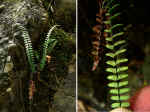
|
|
|
|
|
|
|
|
|
|
|
|
|
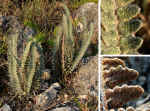
|

|
|
|
|
|
|
|
|
|
|
|
|
|
|
|
|
|
|
|
|
|
|
|
|
|
|
|
|
|

|
|
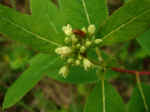
|
|
|
|
|
|
|
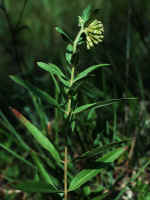
|
|
|
|
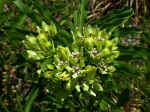
|
|
ASPLENIACEAE
Asplenium platyneuron (L.) B.S.P.
Asplenium resiliens Kunze
DENNSTAEDTIACEAE
Pteridium aquilinum (L.) Kuhn
ISOËTACEAE
*IsoŽtes butleri Engelm., A. and S. 7552
OPHIOGLOSSACEAE
*Ophioglossum engelmannii Prantl, A. and S. 7646
POLYPODIACEAE
Pleopeltis polypodioides (L.) Andrews & Windham var. michauxiana (Weatherby) Andrews & Windham [Polypodium polypodioides (L.) Watt var. michauxianum Weatherby]
PTERIDACEAE
{Adiantum capillus-veneris L.}
*Astrolepis integerrima (Hook.) Benham & Windham [Notholaena integerrima (Hook.) Hevly, Cheilanthes integerrima (Hook.) Mickel], A. 6695
*Cheilanthes alabamensis (Buckl.) Kunze, A. 12574
Cheilanthes lanosa (Michx.) D. C. Eat.
Pellaea atropurpurea (L.) Link
GYMNOSPERMS
CUPRESSACEAE
Juniperus virginiana L. var. virginiana
PINACEAE
Pinus echinata P. Mill.
Pinus palustris P. Mill.
Pinus taeda L.
ANGIOSPERMS
ACANTHACEAE
Ruellia humilis Nutt., A. and S. 7787
Ruellia strepens L.
ACERACEAE
Acer leucoderme Small
AGAVACEAE
Manfreda virginica (L.) Salisb. ex Rose [Agave virginica L., Polianthes virginica (L.) Shinners]
ANACARDIACEAE
Rhus aromatica Ait.
Rhus glabra L.
Toxicodendron pubescens P. Mill. [T. toxicarium Gillis, Rhus toxicodendron L.]
Toxicodendron radicans (L.)
Kuntze [Rhus
radicans L.]
APIACEAE
{Eryngium integrifolium Walt.} (single locality), A. and S. 8112
Eryngium yuccifolium Michx. var. yuccifolium
Thaspium barbinode (Michx.) Nutt. var. chapmanii Coult. & Rose (variety not accepted in PLANTS [USDA 2000]), A. and S. 7558
Thaspium trifoliatum (L.) Gray var. aureum (L.) Britt.
Zizia aptera (Gray) Fern.
APOCYNACEAE
Amsonia ciliata Walt. var. tenuifolia (Raf.) Woods. [A. ciliata Walt. var. filifolia Woods.], A. 10566
Amsonia tabernaemontana Walt.
AQUIFOLIACEAE
{Ilex ambigua (Michx.) Torr.}
ARALIACEAE
*{Panax quinquefolius L.}
ARECACEAE
*{Rhapidophyllum hystrix (Pursh) H. Wendl. & Drude ex Drude}, J. Allison and C. Oberholster 7057 (VDB)
Sabal minor (Jacq.) Pers.
ASCLEPIADACEAE
{Asclepias variegata L.}
Asclepias viridis Walt.
Matelea gonocarpos (Walt.) Shinners, A. 10898